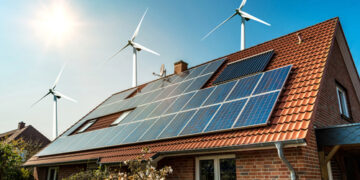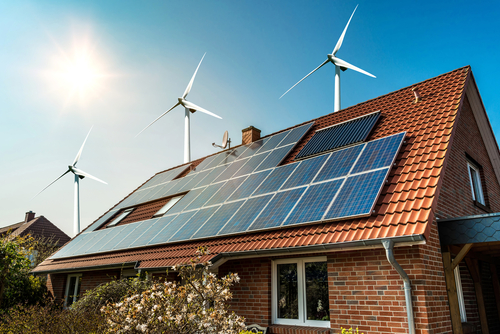Smarter Tech, Greener Living
Technology doesn’t have to be the enemy of sustainability—in fact, it can be one of its most powerful allies. In recent years, green tech has shifted from niche to necessary, helping homeowners cut energy use, reduce waste, and shrink their carbon footprint without giving up comfort or convenience.
From smart thermostats to solar-powered gadgets, the right tech can help you create a home that’s not just efficient—but intentional. The kind of space that reflects a lifestyle of awareness, balance, and forward thinking.
[Ad Banner #1]
Placeholder for the first advertisement.
Reducing Consumption Through Smart Control
The foundation of an eco-conscious tech setup starts with knowing how—and when—you’re using energy. Smart thermostats like Nest, Ecobee, or Tado learn your routine and adjust heating and cooling based on real-time needs.
Why it matters:
-
Heating and cooling make up nearly half of a home’s energy use.
-
Smart thermostats can reduce energy consumption by up to 20%.
-
They often come with rebates from local utility companies.
Many models also track your energy use over time, helping you see patterns and make smarter decisions. And with app-based control, you can make adjustments from anywhere—whether you’re across town or curled up on the couch.
Light the Way with LEDs
If you haven’t already made the switch to LED lighting, now’s the time. LEDs use up to 80% less energy than traditional incandescent bulbs and last 25 times longer. That means fewer replacements, lower bills, and less waste.
Modern LED bulbs come in every shape, color temperature, and brightness level, from warm mood lighting to daylight-mimicking task lamps. Many are also compatible with smart home systems, allowing you to schedule, dim, or turn off lights with voice control or smartphone apps.
Tip: Start with your most-used fixtures—kitchen, bathroom, porch—and build from there.
[Ad Banner #2]
Placeholder for the second advertisement.
Solar Integration: Beyond Rooftop Panels
Solar power is no longer just for full-home systems. These days, solar technology shows up in everyday gadgets that reduce reliance on the grid and make the most of natural energy.
Smart solar tech to consider:
-
Solar-powered outdoor lights: Great for paths, porches, or garden beds—no wiring needed.
-
Solar phone chargers and power banks: Ideal for off-grid energy boosts or emergencies.
-
Solar security cameras: Lower energy use while keeping your home monitored.
Even small solar integrations chip away at your energy demand, especially when paired with efficient appliances and good insulation.
Low-Energy Appliances That Do More with Less
Energy-efficient appliances aren’t just about sticker ratings—they’re central to a low-impact household. Look for ENERGY STAR certified devices, which are tested for performance and sustainability.
What to upgrade (when the time comes):
-
Refrigerator: Modern models use 40% less energy than those from 10 years ago.
-
Washer and dryer: Front-load washers use less water, and heat pump dryers save energy without high heat.
-
Dishwasher: Efficient models clean better with less water and energy, especially on eco cycles.
If you’re not ready for full replacements, smaller upgrades help too: using smart plugs to cut phantom energy, or scheduling appliances during off-peak hours if your utility supports it.
Water-Saving Tech for the Win
Tech isn’t just about electricity—it also helps reduce water use. Products like smart irrigation controllers, low-flow showerheads with timers, and leak detectors give you more control over a precious resource.
Some smart leak sensors even send alerts to your phone if something goes wrong, helping prevent water damage and waste. And timed irrigation systems ensure your garden thrives without overwatering.
Tech That Connects—And Reflects Your Values
It’s easy to get caught up in flashy smart home trends, but true green tech aligns function with values. It’s not about having the latest gadget—it’s about using tech as a tool for stewardship.
That might look like a smart plug that turns off appliances overnight, a compost sensor that tracks conditions in your bin, or a solar-powered motion light that makes your yard safer and more self-reliant.
You don’t need a massive budget or a full system overhaul. Start with one upgrade. Let it pay off, then build from there. Sustainability is a layered process, and every small improvement moves you closer to a more intentional, lower-impact home.
Challenges to Keep in Mind
Like all tools, green tech is only as good as how it’s used. Devices that rely on constant data streaming or short lifespans can still contribute to e-waste and energy overload if not chosen thoughtfully.
Tips for choosing wisely:
-
Prioritize longevity and repairability.
-
Look for products with third-party certifications or eco-labels.
-
Consider open-source or modular tech that can evolve with your needs.
-
Donate or recycle old electronics responsibly through e-waste programs.
A Home That Works With the Planet
An eco-conscious home is one that pays attention—to its inputs, outputs, and the quiet systems in between. Smart gadgets, LED lights, and renewable-powered devices aren’t about showing off—they’re about living lighter, and being part of a future that doesn’t sacrifice comfort for sustainability.
Let your tech reflect your values. Start with what makes sense for your home and your habits. One smart switch today becomes long-term savings—for your wallet, and for the Earth.
























